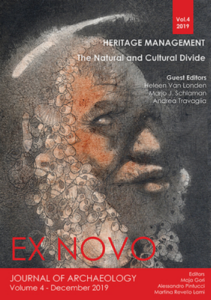Heritage Management: The Natural and Cultural Divide. Edited by Heleen van Londen, Marjo J. Schlaman, and Andrea Travaglia. Oxford: Archaeopress Publishing, 2020.
Reviewed by Mathilde Sbinne
Nature and culture are often seen, perceived, and studied as two opposite and separate poles – especially in the Western world. Edited by landscape, archeology and heritage experts and scholars, Heritage Management: The Natural and Cultural Divide compiles essays and case studies that underscore the potential and need for integrating nature and culture in heritage management. The book addresses urgent and current debates in heritage studies that have implications in terms of tourism management and more broadly for urban and landscape planning.

The book comprises nine chapters, each being an article published in the Ex Novo Journal of Archaeology in 2019. It opens with a foreword from the editorial board. The introduction also written by the book’s editors explains why the natural-cultural heritage divide should be overcome and maps three perspectives: a universal one, a European one, and a human-rights one. It is within the latter that cultural heritage is being included in the climate change discourse. This paradigm shift from the natural-cultural divide to integration sets the framework of the book.
Chapter 1 continues building a theoretical framework around the key concept of landscape, asserting that landscape is a “new commons”, that is a public good embodying both nature and culture. Chapter 2 also illustrates that statement. Three members of the European Association of Archeologists and the European Archaeological Council working group on Farming, Forestry and Rural Land Management assess the impacts management problems of the European Union’s Common Agriculture Policy on archaeological sites and landscapes, but also the benefits of such an integrated policy for archaeological preservation. Chapter 3 advocates for the necessity of integrating cultural resource and natural resource management in the United States. Going more into details, Asa Ahrland takes a historical perspective to explain how natural and cultural values in Sweden were gradually embedded in the conservation of the Ekolsund manorial estate and gardens. Taking a more contemporary view, assistant professor at the Institute of Archaeology in Poznan Kornelia Kajda then analyses the conflictual and complementary heritage discourse of experts and the public in negotiating the process of “herigitization” of the cultural and natural sites. Similarly, in chapter 6, Andrea Travaglia focuses on the Dutch Environmental and Planning Act Omgevingswet and shows that wider collaboration, between citizens and experts, is incrementally important for opening the dialogue of heritage planning. Chapter 7 is an essay in which Heleen Van Londen, a heritage studies professor at the University of Amsterdam, reflects on participatory modes of interaction and suggests a bottom-up heritage management system. In chapter 8, Marjo Schlaman critically questions whether integration is always a good idea. Although there is no conclusion, the last chapter serves as one. It skillfully summarizes the current crossovers between cultural and natural assets and paves the way for future research in heritage studies as well as for heritage management.
The book balances out theoretical and practical dimensions of heritage management and policies. The overarching concept of landscape serves as a common thread. Perhaps the book falls short in explaining methods used in such qualitative research. Intrinsically, it is inter- and trans-disciplinary as it brings together expertise from history, archaeology, heritage studies, tourism studies, museum studies. The usefulness and relevance of this book is that it illustrates how the divide between natural and cultural heritage can be overcome, in various instances and from various angles. At the same time, the case-studies only focus on the Western world, with examples from Europe and the United States. Contributions from non-Western views on heritage formation, heritage discourses and heritage management practices would be very interesting and useful to fully grasp the scope of integrating natural and cultural assets. While the book affirms that the nature-culture divide is obsolete, a crucial question that remains open is whether the integration of nature and culture will be fulfilled in a timely manner, as to mitigate the effects of climate change on heritage sites.
Ultimately, this Heritage Management: The Natural and Cultural Divide delivers a wide array of expert and scholarly perspectives on the relationship between nature and culture in heritage. It paves the way for more interdisciplinary research that bridges nature and culture, as well as for practical integrated heritage management practices, whether it be in landscape, urban or rural planning or in the museum context.
Mathilde Sbinne is a graduate student in the Erasmus Mundus Master “Euroculture: Culture, Society and Politics in a Global Context”. From an interdisciplinary background, her research bridges topics of environmental protection and sustainable development with heritage preservation and tourism management. She is currently doing an exchange semester at the IUPUI School of Liberal Arts and is notably attending classes from the Museum Studies program.

